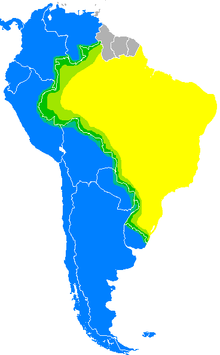Portuñol
| Portuñol, Portunhol | ||
|---|---|---|
|
Spoken in |
Portuguese-Spanish-speaking border regions, for example | |
| speaker | as a spontaneous mixture of languages, potentially anyone who has both Portuguese and Spanish skills; as a (more or less) fixed regional / local language variant (e.g. the portuñol riverense ) an estimated 100,000 speakers | |
| Linguistic classification |
||
| Official status | ||
| Recognized minority / regional language in |
|
|
Portuñol [ poɾtuˈɲol ] ( Portuguese : Portunhol ) are non-standardized mixed languages from Spanish and Portuguese . They are used in different ways in some contact regions of the two languages, especially in the border area between Brazil and its neighboring countries.
term
The term is very well known and widespread, but is not used by the Real Academia Española . A leading Brazilian dictionary listed the term in 1999 and defined it in two ways: firstly, the result of a code-switching mixture of Spanish-Portuguese languages; second, the Spanish spoken by native Portuguese speakers without any knowledge of Spanish. From a linguistic point of view, the popular, clichéd use of the term is criticized, which suggests a situation and distribution of the Portuñol that does not correspond to the real linguistic conditions.
distribution
Portuñol is spoken in South America in regions where Portuguese and Spanish speakers meet. Mixed languages are described especially for the border regions between Brazil and Uruguay , Argentina and Paraguay . In Uruguay, Portuñol is practically widespread in the entire northern half of the country - in gradations depending on the distance to the border, although only about a quarter of the total population lives there. The mixed language is therefore also referred to as fronterizo / fronteiriço (span./port., For example: "borderland"). The language is also partly promoted by regional programs of the TV broadcaster Canal 10, but is generally endangered due to the language policy efforts of the participating governments and the low reputation of its own speakers.
On the Iberian Peninsula , only individual dialects in the border area, especially between Extremadura and Portugal, are described as mixed Spanish-Portuguese languages.
classification
The most famous variant originated in the area of present-day Uruguay, which was long disputed between Spain and Portugal, later Argentina and Brazil, which changed hands several times between 1680 and 1828 (stronghold Rivera in the north of the country, with the local variant portuñol riverense ). The language is considered by both the Uruguayan and the Brazilian side as a dialect or slang ( rompidioma ) and in Uruguay it is called brasilero / brasileiro . The Hispanic speaks officially of "Portuguese dialects in Uruguay" ( Dialectos Portugueses del Uruguay , abbreviated DPU ).
Nevertheless, the inhabitants of the border region ( fronterizos ) have developed a special cultural dynamic and in some cases also a self- confidence as Portuñol speakers.
features
Portuñol is not a language with fixed grammatical rules or a uniform vocabulary. In the Rivera (Uruguay) and across the Brazilian border in the Livramento area , Portuñol is also a sociolinguistic phenomenon. Members of the educated class usually speak both Portuguese and Spanish and can use both languages unmixed as needed. The mixed language is more widespread in the lower classes.
Demarcation
Musicians like Manu Chao , whose father comes from Galicia , have sung in Portuñol. The Galician language , which is closely related to Portuguese and Spanish and very similar to both languages, is not, however, a mixed language.
Web links
Fronteiras / Fronteras - video project (2016/2017) by Ricardo Almeida on the topic of Brazilian border areas (Portuguese, Spanish, Portunhol)
Individual evidence
- ↑ (quoted from the Spanish language Wikipedia :) "El portuñol de la frontera Uruguay-Brasil tiene reconocimiento legal. La Ley General de Educación N ° 18437 de 2008/2009 (Título II, Capítulo VII, Artículo 40, 5)) lo llama portugués del Uruguay . " -> http://www.impo.com.uy/bases/leyes/18437-2008/40
- ↑ a b c d María Jesús Fernández García ( University of Extremadura ): Portuñol y literatura (PDF; 207 kB). In: Revista de estudios extremeños , ISSN 0210-2854, Vol. 62 (2006), No. 2, pp. 555-576.
- ^ A b Silvia Etel Gutiérrez Bottaro ( USP ): El fenómeno del bilingüismo en la comunidad fronteriza uruguayo-brasileña de Rivera. In: Files of the 2nd Congress of Brazilian Hispanists, São Paulo, October 2002, published online on SciELO , accessed July 2018.
